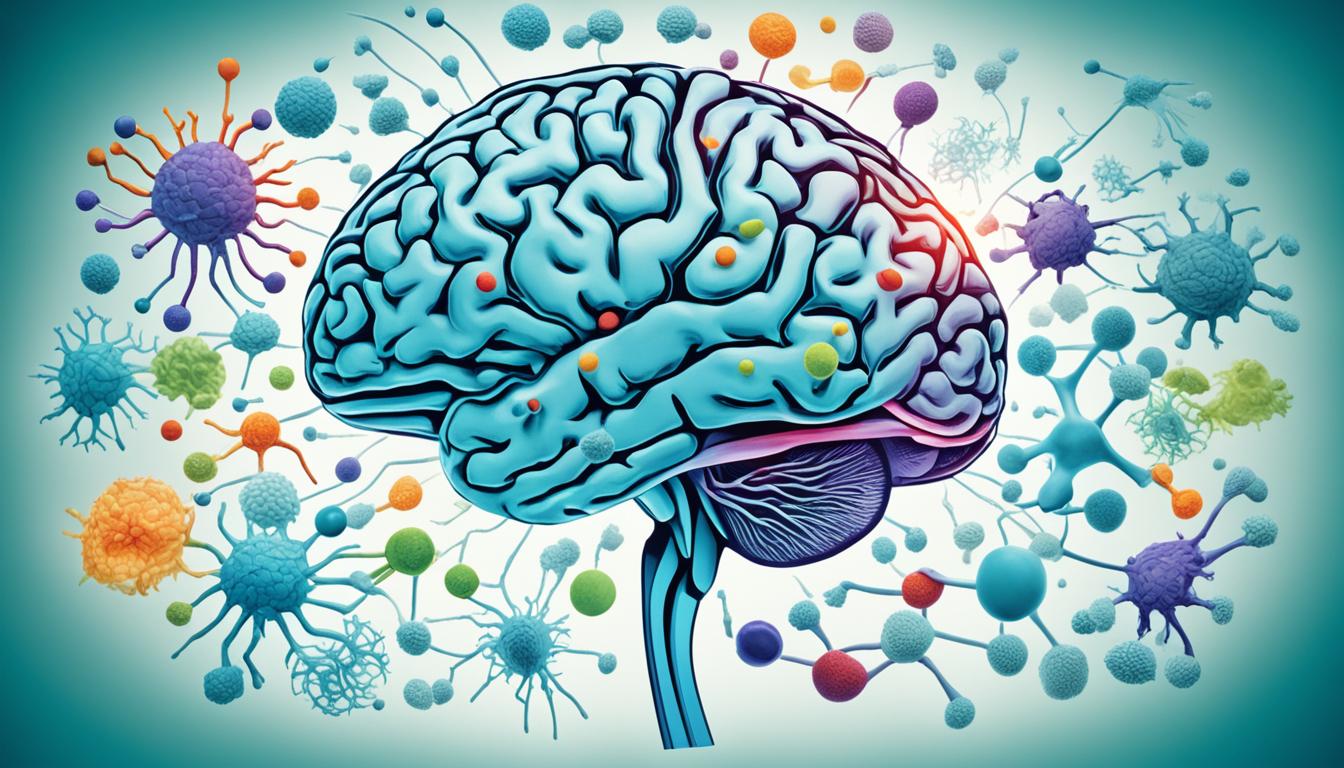Frontotemporal dementia (FTD) is a group of diseases that harm the front and side areas of the brain. It includes different types, such as Picks disease and primary progressive aphasia. FTD brings on issues with talking, memory, behavior, compulsive shopping, and social skills. The real cause is unknown, but it might come from genes and build-up of certain proteins.
FTD doesn’t have a cure yet. Doctors work to ease its symptoms. But, there’s new hope with stem cell therapy, which could help in treating FTD.
Key Takeaways:
- Frontotemporal dementia (FTD) affects the front and side brain areas.
- Its signs are troubles with speech, memory, behavior changes, and more.
- The main FTD cause is unclear, but genes and protein build-up play a part.
- Currently, there’s no cure for FTD, and care mainly focuses on symptom management.
- Stem cell therapy holds promise for FTD treatment.
Understanding Frontotemporal Dementia
Frontotemporal dementia (FTD) affects the frontal and temporal lobes, changing the brain’s function. It comes in different subtypes, including Picks disease. Each form shows in unique ways, typically with language and behavior changes.
The cause of FTD is complex, including genetic and protein buildup factors. Brain damage in these areas leads to the disease’s effects on behavior and emotions. Unlike Alzheimer’s, FTD mainly impacts people aged 40 to 65.
FTD diagnosis involves detailed examination and brain scans. Tests like MRI and PET scans reveal brain changes. Genetic tests might be done due to FTD’s genetic links.
There’s no cure for FTD yet. But, management can include drugs, therapy, and support. SSRIs help with mood, and therapy aids in language issues.
Subtypes of Frontotemporal Dementia
| Subtype | Features |
|---|---|
| Behavioral variant FTD (bvFTD) | – Changes in behavior and personality – Emotional blunting – Social disinhibition – Loss of empathy |
| Primary progressive aphasia (PPA) | – Language impairment – Difficulty finding words – Problems with grammar and word comprehension |
| Semantic dementia | – Loss of vocabulary and word meaning – Difficulty recognizing objects and faces |
| Corticobasal syndrome | – Movement problems – Muscle stiffness and rigidity – Difficulty with coordination and balance |
| Picks disease | – Changes in behavior and personality – Executive function deficits – Language impairment |
Treatments aim to ease symptoms, but their effect varies. Current research looks for better, more focused therapies, perhaps including stem cell treatment.
Diagnosis and Treatment Options for FTD
Diagnosing frontotemporal dementia (FTD) means checking the patient’s symptoms and history. Doctors also do a physical and look at images of the brain. They might advise genetic testing since some genes are tied to FTD.
The aim of treating FTD is to ease symptoms and boost the patient’s life quality. This involves taking medications and trying other therapies. Doctors might give drugs like acetylcholine inhibitors for memory and language, or anti-psychotics for behavior issues.
Researchers are also looking into stem cell therapy for FTD. This method uses stem cells to renew brain cells. It shows promise but needs more study. Stem cell therapy has helped in other brain diseases, offering hope for FTD too.
Treatment Options for FTD:
| Treatment Type | Description |
|---|---|
| Medications | Prescribed to target specific symptoms, such as memory problems, language impairment, mood symptoms, and behavioral disturbances. |
| Stem Cell Therapy | An innovative approach that involves the use of stem cells to replace damaged or dysfunctional cells in the brain. |
| Behavioral Therapy | Focuses on managing behavioral changes and improving social interactions for individuals with FTD. |
| Supportive Care | Provides assistance and support to both patients and their caregivers, helping them navigate the challenges associated with FTD. |
| Speech and Language Therapy | Aims to improve communication abilities for individuals experiencing language impairment due to FTD. |
| Occupational Therapy | Helps individuals with FTD maintain their independence and improve their ability to perform daily activities. |
There’s still no absolute cure for FTD. Yet, the medical world is making progress. By catching and treating FTD early, healthcare teams aim to better the lives of those with the disease.
Conclusion
Frontotemporal dementia (FTD) is a disease that harms parts of the brain. These parts control our actions and speaking. People with FTD can have trouble remembering things, change how they act, and find it hard to talk.
There’s no cure for FTD yet. But, doctors have ways to help manage it. They may give medicines to help with memory and talking problems.
Stem cell therapy is also being looked at for FTD. It uses special cells to fix the brain’s damaged ones. This therapy has already helped with other brain problems.
We still need more research on stem cell therapy for FTD. This research will tell us if it’s really helpful. The goal is to find better ways to handle FTD and maybe even cure it.

